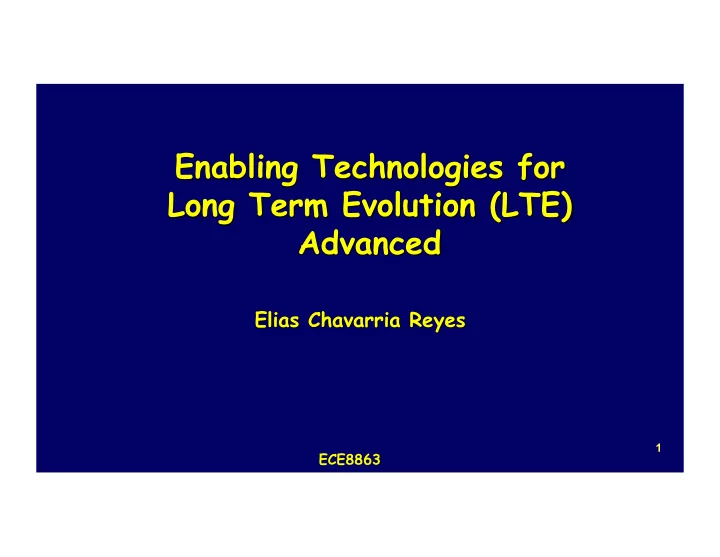

1 ECE8863
ECE8863 2
ECE8863 3
ECE8863 4
ECE8863 5
ECE8863 6
ECE8863 7
ECE8863 8
ECE8863 9
ECE8863 10
ECE8863 11
ECE8863 12
Deployment Scenario No of LTE-A component carriers Scenario Transmission BWs of Bands for LTE-A Duplex No. LTE-A carriers carriers modes UL: 40 MHz UL: Contiguous 2x20 MHz CCs A Single-band contiguous spec. 3.5 GHz band FDD alloc. @ 3.5GHz band for FDD DL: 80 MHz DL: Contiguous 4x20 MHz CCs Single-band contiguous spec. Band 40 (2.3 GHz) B ¡ 100 MHz ¡ Contiguous 5x20 MHz CCs ¡ TDD ¡ alloc. @ Band 40 for TDD UL: 40 MHz UL/DL: Non-contiguous 10 MHz Band 3 (1.8 GHz) C Multi-band non-contiguous spec. FDD alloc. @ Band 1, 3 and 7 for FDD CC@Band 1 + 10 MHz CC@Band 3 + 20 Band 1 (2.1 GHz) DL: 40 MHz MHz CC@Band 7 Band 7 (2.6 GHz) Multi-band non-contiguous spec. Band 39 (1.8GHz) D 90 MHz Non-contiguous 2x20 + 10 + 2x20 MHz TDD CCs alloc. @ Band 39, 34, and 40 for Band 34 (2.1GHz) TDD Band 40 (2.3GHz) ECE8863 13
ECE8863 14
ECE8863 15
ECE8863 16
ECE8863 17
ECE8863 18
ECE8863 19
ECE8863 20
ECE8863 21
ECE8863 22
ECE8863 23
ECE8863 24
ECE8863 25
ECE8863 26
ECE8863 27
What is the optimum number of relays? What is the optimum location/ layout? What is the optimum transmission/reception schedules with UE/BSs? What type of relay What is the optimum/maximum should be used in number of hops? => multi-hop different scenarios? relay ECE8863 28
ECE8863 29
Is there any clear benefit compared to L1? ECE8863 30
ECE8863 31
ECE8863 32
ECE8863 33
Only for one user Rx Diversity (2 or 4 antennas) Open-loop Tx Diversity with SFBC Closed loop (PMI) Codebook-based precoding ECE8863
Accomodation of demand for higher data and wider coverage by switching scheme: • SU-MIMO for high peak rates • MU-MIMO for average rate enhancement • Collaborative MIMO for cell edge user data rate boost ECE8863 35
ECE8863
Downlink Leverage throughput through SMUX. Network MIMO & Collaborative MIMO Network MIMO for DL only in TDD mode For FDD: collaborative+MU MIMO+SU MIMO UE Sync to more than Same resources are one cell and Network used for each UE Sync. Increased feedback signaling ECE8863
ECE8863 38
ECE8863 39
ECE8863 40
Coordinated scheduling/beamforming Dynamic multi-site scheduling Coordinated precoder design and beam allocation Each payload data transmitted only from one cell No carrier phase coherence requirement No impact on radio; only X2 interface ECE8863
ECE8863 42
ECE8863 43
ECE8863 44
Recommend
More recommend